No to Criminalization of Dissent
•
Our Security Lies in the Fight for the Rights of All
• Repress U, Class of 2012: Seven Steps to a Homeland Security Campus • New Surveillance Measures Extend Spying When No Suspicion Exists
• Action in Georgia Opposes Criminalization of Dissent
No to Criminalization of Dissent
Our Security Lies in the Fight for the Rights of All
 In March Obama signed a law that effectively outlaws protests near people under Secret Service protection and makes those who engage in such protests subject to a felony offense. Major upcoming demonstrations this year, including those against NATO in Chicago May 19-20, the Republican National Convention (August 27-30, Tampa, Florida) and the Democratic National Convention (September 3-6, Charlotte, North Carolina) will all be impacted by this law. As well, demonstrations inside Congressional and statehouse buildings could also be impacted, with charges against protesters going from simple misdemeanor trespass to felonies. Even though these are public buildings that are supposed to serve the public interest.
In March Obama signed a law that effectively outlaws protests near people under Secret Service protection and makes those who engage in such protests subject to a felony offense. Major upcoming demonstrations this year, including those against NATO in Chicago May 19-20, the Republican National Convention (August 27-30, Tampa, Florida) and the Democratic National Convention (September 3-6, Charlotte, North Carolina) will all be impacted by this law. As well, demonstrations inside Congressional and statehouse buildings could also be impacted, with charges against protesters going from simple misdemeanor trespass to felonies. Even though these are public buildings that are supposed to serve the public interest.
Obama also issued an Executive Order reaffirming executive authority to take broad actions in the name of “national defense preparedness.” Obama’s order added wording to allow these broad authorities to be done incrementally and “under both emergency and non-emergency conditions.” As one example, given increasing U.S. preparations for war, which requires more secure energy resources, this order could well be implemented to expand oil and natural gas drilling using fracking despite widespread opposition and demonstrations opposing such actions (see VOR update March 20, 2012).
In addition, on March 22, Attorney General Eric H. Holder Jr. signed new guidelines for the National Counterterrorism Center greatly expanding its ability to spy on Americans when there is no suspicion of terrorism. The guidelines expand the ability of the center, which is said to be the clearinghouse for data gathered by the various policing agencies, to do “pattern analysis” and “social mapping” of Americans not even suspected of a crime, let alone guilty of one.
It is well-known that such spying is done on the basis of racist and religious profiling, as well as targeting political dissent. The government’s “pattern analysis” and “datamining” all involve branding “radical” ideologies, especially those opposing U.S. imperialism, as “threats.”
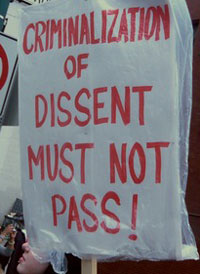 Holder’s guidelines were also issued in the face of recent reports that the New York Police Department (NYPD) together with the CIA engaged in broad spying and profiling of Muslims, including infiltrating mosques and Muslim Student Associations across New York and outside the state. The CIA and NYPD have no authority to do these actions yet far from any charges or punishment, government spying and criminalization of dissent is being expanded. These various actions follow passage of the National Defense Authorization Act, which included authorizing the president and military to indefinitely detain anyone without charges or trial.
Holder’s guidelines were also issued in the face of recent reports that the New York Police Department (NYPD) together with the CIA engaged in broad spying and profiling of Muslims, including infiltrating mosques and Muslim Student Associations across New York and outside the state. The CIA and NYPD have no authority to do these actions yet far from any charges or punishment, government spying and criminalization of dissent is being expanded. These various actions follow passage of the National Defense Authorization Act, which included authorizing the president and military to indefinitely detain anyone without charges or trial.
Criminalization of dissent is a means to terrorize and silence the public at a time when it needs to be energized and politicized. It is a means to depoliticize the public and eliminate the concept that government exists to serve the public good, not monopoly right. The recent actions, alongside the whole experience of the “war on terror” makes clear that “national security” has nothing to do with protecting the public and the public interest. On the contrary it serves private monopoly interests, such as those of the war monopolies.
Our security lies in the fight for the rights of all, at home and abroad. It lies in being political, that is identifying and fighting for our individual and collective interests and the general interests of society. It means striving to harmonize those interests and humanize society.
Human beings are social political beings. To be depoliticized, to have public right, including the right to dissent, ruthlessly under attack as is now occurring, is to be dehumanized.
A government and state whose reason for being is “national security” is not fit for human beings. This means it is not enough to oppose the current attacks. It is necessary to both resist and organize for a society of our own making that puts the rights of all at the center. It is necessary to organize now, today to develop mechanisms of political empowerment, where the people themselves are the decision-makers.
[TOP]
Repress U, Class of 2012: Seven Steps to a Homeland Security Campus
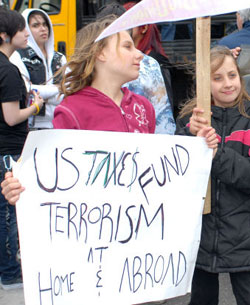 Campus spies. Pepper spray. SWAT teams. Twitter trackers. Biometrics. Student security consultants. Professors of homeland security studies. Welcome to Repress U, class of 2012.
Campus spies. Pepper spray. SWAT teams. Twitter trackers. Biometrics. Student security consultants. Professors of homeland security studies. Welcome to Repress U, class of 2012.
Since 9/11, the homeland security state has come to campus just as it has come to America’s towns and cities, its places of work and its houses of worship, its public space and its cyberspace. But the age of (in)security had announced its arrival on campus with considerably less fanfare than elsewhere — until, that is, the “less lethal” weapons were unleashed in the fall of 2011.
Today, from the City University of New York to the University of California, students increasingly find themselves on the frontlines, not of a war on terror, but of a war on “radicalism” and “extremism.” Just about everyone from college administrators and educators to law enforcement personnel and corporate executives seems to have enlisted in this war effort. Increasingly, American students are in their sights.
Seven Steps To Police-State Campuses
In 2008, I laid out seven steps the Bush administration had taken to create a homeland security campus. Four years and a president later, Repress U has come a long way. In the Obama years, it has taken seven more steps to make the university safe for plutocracy. Here is a step-by-step guide to how they did it.
Target Dissent
[…] The mass pepper spraying of students at UC Davis was only the most public manifestation of a long-running campus trend in which, for officers of the peace, the pacification of student protest has become part of the job description. The weapons of choice have sometimes been blunt instruments, such as the extendable batons used to bludgeon the student body at Berkeley, Baruch, and the University of Puerto Rico. At other times, tactical officers have turned to “less-lethal” munitions, like the CS gas, beanbag rounds, and pepper pellets fired into crowds.
Yet for everything we see of the homeland security campus, there is a good deal more that we miss. Behind the riot suits, the baton strikes, and the pepper-spray cannons stands a sprawling infrastructure made possible by multimillion-dollar federal grants, “memoranda of understanding” and “mutual aid” agreements among law enforcement agencies, counter-terrorism training, an FBI-sponsored “Academic Alliance,” and 103 Joint Terrorism Task Forces (which provide “one-stop shopping” for counterterrorism operations to more than 50 federal and 600 state and local agencies).
“We have to go where terrorism takes us, so we often have to go onto campuses,” FBI Special Agent Jennifer Gant told Campus Safety Magazine in an interview last year. To that end, campus administrators and campus police chiefs are now known to coordinate their operations with Department of Homeland Security (DHS) “special advisors,” FBI “campus liaison agents,” an FBI-led National Security Advisory Board, and a Federal Law Enforcement Training Center, which instructs local law enforcement in everything from “physical techniques” to “behavioral science.” More than half of campus police forces already have “intelligence-sharing agreements” with these and other government agencies in place.
Get a SWAT team
Since 2007, campus police forces have decisively escalated their tactics, expanded their arsenals, and trained ever more of their officers in SWAT-style paramilitary policing. Many agencies acquire their arms directly from the Department of Defense through a surplus weapons sales program known as “1033,” which offers, among other things, “used grenade launchers (for the deployment of less lethal weapons)... for a significantly reduced cost.”
According to the most recent federal data available, nine out of 10 campus agencies with sworn police officers now deploy armed patrols authorized to use deadly force. Nine in 10 also authorize the use of chemical munitions, while one in five make regular use of Tasers. Last August, an 18-year old student athlete died after being tased at the University of Cincinnati.
Meanwhile, many campus police squads have been educated in the art of war through regular special weapons training sessions by “tactical officers’ associations” which run a kind of SWAT university. In October, UC Berkeley played host to an “Urban Shield” SWAT training exercise involving local and campus agencies, the California National Guard, and special police forces from Israel, Jordan, and Bahrain. And since 2010, West Texas A&M has played host to paramilitary training programs for police from Mexico.
In October, the University of North Carolina at Charlotte got its very own SWAT team, equipped with MP-15 rifles, M&P 40 sidearms, and Remington shotguns. “We have integrated SWAT officers into the squads that serve our campus day and night,” boasted UNC Charlotte Chief of Police Jeff Baker. The following month, in Chapel Hill, North Carolina, a SWAT team staged an armed raid on an occupied building, pointing assault rifles at the heads of activists, among them UNC students.
Spy on Muslims
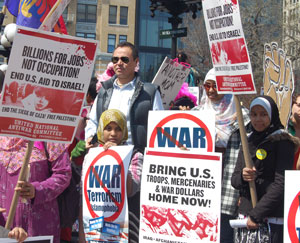 The long arm of Repress U stretches far beyond the bounds of any one campus or college town. As reported by the Associated Press this winter, the New York City Police Department (NYPD) and its hitherto secret “Demographics Unit” sent undercover operatives to spy on members of the Muslim Students Association (MSA) at more than 20 universities in four states across the Northeast beginning in 2006.
The long arm of Repress U stretches far beyond the bounds of any one campus or college town. As reported by the Associated Press this winter, the New York City Police Department (NYPD) and its hitherto secret “Demographics Unit” sent undercover operatives to spy on members of the Muslim Students Association (MSA) at more than 20 universities in four states across the Northeast beginning in 2006.
None of the organizations or persons of interest were ever accused of any wrongdoing, but that did not stop NYPD detectives from tracking Muslim students through a “Cyber Intelligence Unit,” issuing weekly “MSA Reports” on local chapters of the Muslim Students Association, attending campus meetings and seminars, noting how many times students prayed, or even serving as chaperones for what they described as “militant paintball trips.” The targeted institutions ran the gamut from community colleges to Columbia and Yale.
According to the AP’s investigation, the intelligence units in question worked closely not only with agencies in other cities, but with an agent on the payroll of the CIA. Police Commissioner Ray Kelly, facing mounting calls to resign, has issued a spirited defense of the campus surveillance program, as has Mayor Michael Bloomberg. “If terrorists are not limited by borders and boundaries, we cannot be either,” Kelly said in a speech at Fordham Law School.
The NYPD was hardly the only agency conducting covert surveillance of Muslim students on campus. The FBI has been engaging in such tactics for years. In 2007, UC Irvine student Yasser Ahmed was assaulted by FBI agents who followed him as he was on his way to a campus “free speech zone.” In 2010, Yasir Afifi, a student at Mission College in Santa Clara, California, found a secret GPS tracking device affixed to his car. A half-dozen agents later knocked on his door to ask for it back.
Keep the undocumented out
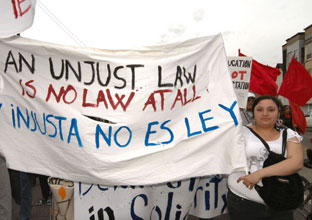 Foreign students are followed closely by Immigration and Customs Enforcement (ICE) through its Student and Exchange Visitor Information System (SEVIS). As of 2011, the agency was keeping tabs on 1.2 million students and their dependents. Most recently, as part of a transition to the paperless SEVIS II —which aims to “unify records” — ICE has been linking student files to biometric and employer data collected by DHS and other agencies.
Foreign students are followed closely by Immigration and Customs Enforcement (ICE) through its Student and Exchange Visitor Information System (SEVIS). As of 2011, the agency was keeping tabs on 1.2 million students and their dependents. Most recently, as part of a transition to the paperless SEVIS II —which aims to “unify records” — ICE has been linking student files to biometric and employer data collected by DHS and other agencies.
“That information stays forever,” notes Louis Farrell, director of the ICE program. “And every activity that has ever been associated with that person will come up. That is something that has been asked for by the national security community... [and] the academic community.”
Then there are the more than 360,000 undocumented students and high-school graduates, brought to the U.S. as children, who would qualify for permanent resident status and college admission […] When such students started “coming out” as part of an “undocumented and unafraid” campaign, many received DHS notices to appear for removal proceedings. Take 24-year old Uriel Alberto, of Lees-McRae College, who recently went on hunger strike in North Carolina’s Wake County jail; he now faces deportation (and separation from his U.S.-born son) for taking part in a protest at the state capitol.
Since 2010, the homeland security campus has been enlisted by the state of Arizona to enforce everything from bans on ethnic studies programs to laws like S.B. 1070, which makes it a crime to appear in public without proof of legal residency and is considered a mandate for police to detain anyone suspected of being undocumented. Many undocumented students have turned down offers of admission to the University of Arizona since the passage of the law, while others have stopped attending class for fear of being detained and deported.
Keep an eye on student spaces and social media
While Muslim and undocumented students are particular targets of surveillance, they are not alone. Electronic surveillance has expanded beyond traditional closed-circuit TV cameras to next-generation technologies like IQeye HD megapixel cameras, so-called edge devices (cameras that can do their own analytics), and Perceptrak’s video analytics software, which “analyzes video from security cameras 24/7 for events of interest,” and which recently made its debut at Johns Hopkins University and Mount Holyoke College.
At the same time, students’ social media accounts have become a favorite destination for everyone from campus police officers to analysts at the Department of Homeland Security.
In 2010, the DHS National Operations Center established a Media Monitoring Capability (MMC). According to an internal agency document, MMC is tasked with “leveraging news stories, media reports and postings on social media sites… for operationally relevant data, information, analysis, and imagery.” The definition of operationally relevant data includes “media reports that reflect adversely on DHS and response activities,” “partisan or agenda-driven sites,” and a final category ambiguously labeled “research/studies, etc.” […]
According to a how-to guide called “Essential Ingredients to Working with Campus Protests” by UC Santa Barbara police chief Dustin Olson, the first step to take is to “monitor social media sites continuously,” both for intelligence about the “leadership and agenda” and “for any messages that speak to violent or criminal behavior.”
Co-opt the classroom and the laboratory
 At a time when entire departments and disciplines are facing the chopping block at America’s universities, the Department of Homeland Security has proven to be the best-funded department of all. Homeland security studies have become a major growth sector in higher education and now have more than 340 certificate- and degree-granting programs. Many colleges have joined the Homeland Security and Defense Education Consortium, a spinoff of the U.S. Northern Command (the Department of Defense’s “homeland defense” division), which offers a model curriculum to its members.
At a time when entire departments and disciplines are facing the chopping block at America’s universities, the Department of Homeland Security has proven to be the best-funded department of all. Homeland security studies have become a major growth sector in higher education and now have more than 340 certificate- and degree-granting programs. Many colleges have joined the Homeland Security and Defense Education Consortium, a spinoff of the U.S. Northern Command (the Department of Defense’s “homeland defense” division), which offers a model curriculum to its members.
This emerging discipline has been directed and funded to the tune of $4 billion over the last five years by DHS. The goal, according to Dr. Tara O’Toole, DHS Undersecretary of Science & Technology, is to “leverag[e] the investment and expertise of academia… to meet the needs of the department.” Additional funding is being made available from the Pentagon through its blue-skies research arm, the Defense Advanced Research Projects Agency, and the “intelligence community” through its analogous Intelligence Advanced Research Projects Activity.
At the core of the homeland security-university partnership are DHS’s 12 centers of excellence. (A number that has doubled since … 2008.) The DHS Office of University Programs advertises the centers of excellence as an “extended consortium of hundreds of universities” which work together “to develop customer-driven research solutions” and “to provide essential training to the next generation of homeland security experts.”
But what kind of research is being carried out at these centers of excellence, with the support of tens of millions of taxpayer dollars each year? Among the 41 “knowledge products” currently in use by DHS or being evaluated in pilot studies, we find an “extremist crime database,” a “Minorities at Risk for Organizational Behavior” dataset, analytics for aerial surveillance systems (drones) along the border, and social media monitoring technologies. Other research focuses include biometrics, “suspicious behavior detection,” and “violent radicalization.”
Privatize, subsidize, and capitalize
Repress U has not only proven a boon to hundreds of cash-starved universities, but also to big corporations as higher education morphs into hired education. While a majority of the $184 billion in homeland security funding in 2011 came from government agencies like DHS and the Pentagon, private sector funding is expected to make up an increasing share of the total in the coming years, according to the Homeland Security Research Corporation, a consulting firm serving the homeland security industry.
Each DHS Center of Excellence has been founded on private-public partnerships, corporate co-sponsorships, and the leadership of “industry advisory boards” which give big business a direct stake and say in its operations. Corporate giants allied with DHS Centers of Excellence include:
• Lockheed Martin at the Consortium for the Study of Terrorism and Responses to Terrorism (START), based at the University of Maryland at College Park.
• Alcatel-Lucent and AT&T at the Rutgers University-based Command, Control, and Interoperability Center for Advanced Data Analysis (CICADA).
• ExxonMobil and Con Edison at the Center for Risk and Economic Analysis of Terrorism Events (CREATE), based at the University of Southern California.
• Motorola, Boeing, and Bank of America at the Purdue University-based Center for Visual Analytics for Command, Control, and Interoperability Environments (VACCINE).
• Wal-Mart, Cargill, Kraft, and McDonald’s at the National Center for Food Protection and Defense (NCFPD), based at the University of Minnesota-Twin Cities.
What is more, universities have struck multimillion-dollar deals with multinational private security firms like Securitas, deploying unsworn, underpaid, often untrained “protection officers” on campus as “extra eyes and ears.” The University of Wisconsin-Madison, in one report, boasts that police and private partners have been “seamlessly integrated.”
Elsewhere, even students have gotten into the business of security. The private intelligence firm STRATFOR, for example, recently partnered with the University of Texas to use its students to “essentially parallel the work of… outside consultants” but on campus, offering information on activist groups like the Yes Men.
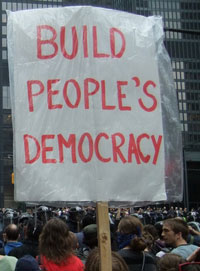 Step by step, at school after school, the homeland security campus has executed a silent coup in the decade since September 11th. The university, thus usurped, has increasingly become an instrument not of higher learning, but of intelligence gathering and paramilitary training, of profit-taking on behalf of America’s increasingly embattled “1%.”
Step by step, at school after school, the homeland security campus has executed a silent coup in the decade since September 11th. The university, thus usurped, has increasingly become an instrument not of higher learning, but of intelligence gathering and paramilitary training, of profit-taking on behalf of America’s increasingly embattled “1%.”
Yet the next generation may be otherwise occupied. Since September 2011, a new student movement has swept across the country, making itself felt most recently on March 1 with a national day of action to defend the right to education. This wave of on-campus activism is making visible what was once invisible, calling into question what was once beyond question, and counteracting the logic of Repress U with the logic of nonviolence and education for democracy.
For many, the rise of the homeland security campus has provoked some basic questions about the aims and principles of a higher education: Who does the university serve? Who does it protect? Who is to speak? Who is to be silenced? To who does the future belong? […]
Michael Alexander Gould-Wartofsky is a writer from New York City
[TOP]
New Surveillance Measures Extend Spying
When No Suspicion Exists
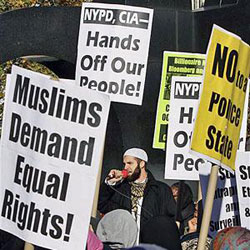 Attorney General Eric H. Holder Jr. signed new guidelines March 22 for the National Counterterrorism Center greatly expanding its ability to spy on Americans when there is no suspicion of terrorism. The Center was created in 2004 to serve as a clearinghouse for the vast databases accumulated by various policing agencies, like the FBI, ICE, various Joint Terrorism Task Forces, and so forth.
Attorney General Eric H. Holder Jr. signed new guidelines March 22 for the National Counterterrorism Center greatly expanding its ability to spy on Americans when there is no suspicion of terrorism. The Center was created in 2004 to serve as a clearinghouse for the vast databases accumulated by various policing agencies, like the FBI, ICE, various Joint Terrorism Task Forces, and so forth.
The guidelines will lengthen to five years — from 180 days — the amount of time the center can retain private information about Americans who are not involved in or even suspected of being involved in any terrorism. The guidelines are will allow the center increase copying entire databases and then "data mining” them using complex algorithms to search for patterns. What the patterns are, what the government considers a “threat,” as well as sources for such databases, such as internet servers, is not elaborated.
The changes are said to allow analysts to more quickly identify “terrorism” suspects, even though the databases includes millions of emails, texts, social networking posts, travel records, credit card transactions and more from millions of people not suspected of terrorism.
The center has developed a priority list of databases it wants to copy entirely, but he and other officials declined to say which ones they were. (The Department of Homeland Security says it has already shared several entire databases, including records related to refugees, foreign students and international travelers.)
As recent reports of the extensive illegal spying and “social mapping” by the CIA and New York Police Department (NYPD) already indicate, the government is engaging in systematically mapping people suspected of no crime whatever. Instead, the government uses racist and religious profiling, targets those organizing dissent, and more broadly attempts to use such spying to both assess public opinion while terrorizing the population. Spying with impunity by agencies like the CIA and NYPD, when no crime or terrorism exists, is what the new guidelines, and the center itself, facilitate.
The older guidelines set up three tracks by which the center can retrieve information gathered by another agency: by doing a limited search itself for certain data, by asking another agency to perform such a search, or — in cases where neither was sufficient — by replicating the database and analyzing the information itself.
The new guidelines keep that structure in place, but expand use of the third track. As part of this they allow the center to completely copy databases and conduct “pattern analysis,” which was largely prohibited before. The datamining is now officially allowed. The extended period of time to hold the data, five years instead of 180 days, also serves this purpose. The new guidelines also coincide with government plans to have greater access to telecommunications information, in the name of “national security.” The government wants to further expand its spying and collection of information in the name of “protecting” critical infrastructure.
The new rules say nothing about restricting or preventing use of commercial data — like credit card and travel records — that may have been acquired by other agencies. In 2009, Wired Magazine secured a list of databases from the Federal Bureau of Investigation, one of the agencies that shares information with the center. It included nearly 200 million records from private data brokers like ChoicePoint, 55,000 entries on customers of Wyndham hotels, and numerous other travel and commercial records.
The timing of the guidelines also corresponds to the recent Executive Order issued by President Obama that provides broad authority to the government to secure resources, also in the name of “national security.”
[TOP]
Action in Georgia Opposes
Criminalization of Dissent
 On March 17, Georgia unions and various rights organizations marched on the Georgia State Capitol in Atlanta to oppose passage of a state bill criminalizing union pickets and demonstrations. The action followed earlier demonstrations demanding the bill be withdrawn. Senate Bill 469, if passed, criminalizes peaceful acts of protest outside of any privately owned building. This includes union pickets of factories, corporate headquarters, and so on. Current demonstrations in front of AT&T headquarters, for example, would be outlawed. Even planning for such demonstrations will now be considered “conspiracy to commit criminal trespass.”
On March 17, Georgia unions and various rights organizations marched on the Georgia State Capitol in Atlanta to oppose passage of a state bill criminalizing union pickets and demonstrations. The action followed earlier demonstrations demanding the bill be withdrawn. Senate Bill 469, if passed, criminalizes peaceful acts of protest outside of any privately owned building. This includes union pickets of factories, corporate headquarters, and so on. Current demonstrations in front of AT&T headquarters, for example, would be outlawed. Even planning for such demonstrations will now be considered “conspiracy to commit criminal trespass.”
Individuals or union members or any individual employees who participate in such protests could be fined up to $1,000 a day, and organizations, which support such actions, could face penalties of up to $10,000 a day. Moreover, the bill makes it a high and aggravated misdemeanor to plan acts of protest in front of private buildings. The bill also includes other anti-worker and anti-union provisions that are basically “Right to be Slave Labor Laws,” (usually called “right to work” laws). The law is a means to eliminate unions as defense organizations and rob them of funding, both through criminalization and through blocking dues collection at the workplace.
SB 469 is similar to “Right to be Slave Labor” legislation recently passed in Indiana and proposed elsewhere, though it broadens the content to be not only anti-worker but to criminalize dissent of all concerned. The interests of the public and their rights are being criminalized, while monopoly rights to repress and plunder the workers here and worldwide are protected. Legislation of this type is serving to politicize private interests, like those of AT&T and Verizon, while depoliticizing the public and its interests. What is needed is standing up for Public Right. Public Right Yes, Monopoly Right NO!
[TOP]
